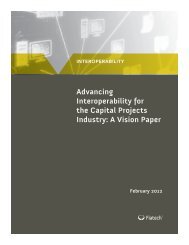An Introduction to ISO 15926 November 2011 - iRINGToday
An Introduction to ISO 15926 November 2011 - iRINGToday
An Introduction to ISO 15926 November 2011 - iRINGToday
You also want an ePaper? Increase the reach of your titles
YUMPU automatically turns print PDFs into web optimized ePapers that Google loves.
temp dTemp Normal Operating Temperature degF<br />
press dPress Normal Operating Pressure psig<br />
ifc dateIFC Issued for Construction Date yyyymmdd<br />
Again, without having <strong>to</strong> change the construction application in any way she builds an import<br />
function that expects <strong>to</strong> receive attributes with names from the common dictionary and maps<br />
them <strong>to</strong> the attribute names in the construction application. There are several advantages <strong>to</strong><br />
using a common dictionary that are important <strong>to</strong> note.<br />
• The developer of the engineering application does not have <strong>to</strong> know anything at all about<br />
the construction application. Indeed, he does not even have <strong>to</strong> know it exists.<br />
• The developer of the construction application does not have <strong>to</strong> know anything at all about<br />
the engineering application—beyond, of course, knowing that it is the source of certain<br />
input data.<br />
• Both of the developers are now free <strong>to</strong> modify their respective applications in any manner,<br />
including massive changes <strong>to</strong> their data structure—as long as the output and input are<br />
mapped <strong>to</strong> the same common dictionary.<br />
• Both developers know the precise meaning of the input/output from each other’s application<br />
because they know the precise meaning of the dictionary term they are mapped <strong>to</strong>.<br />
We call this “semantic precision.”<br />
Of course, there is a cost <strong>to</strong> developing a common dictionary. Someone has <strong>to</strong> herd the cats<br />
<strong>to</strong>gether <strong>to</strong> decide on the meaning of each term and what <strong>to</strong> call them. This is not trivial.<br />
Many people, each with different interests and agendas, have <strong>to</strong> look at the applications in<br />
question—possibly having <strong>to</strong> make fine distinctions between very similar attributes, as well as<br />
build in some allowance for growth.<br />
In short, there is a great deal of initial work in making a common dictionary but in a large<br />
organization it is recouped whenever a new application joins the confederation. For instance,<br />
when a procurement officer needs information from the engineering application <strong>to</strong> use in a<br />
procurement application instead of examining the content of the engineering application’s<br />
database all a software developer has <strong>to</strong> do is consult the dictionary and determine the values<br />
he wants <strong>to</strong> use.<br />
Procurement App Dictionary ID Description Units<br />
tag szTag Tag Number of a plant object<br />
dia dDia<br />
Nominal Diameter per ASME/ANSI<br />
B36.10<br />
len dLen Pressure Class per ASME/ANSI B16.10<br />
ifc dateIFC Issued for Construction Date yyyymmdd<br />
The fact that the engineering application is exposing other data attributes is not of interest.<br />
The procurement application (Figure 1.11) will simply choose the four data items it needs and<br />
use them. Creating the common dictionary made the first mapping exercise take a bit longer,<br />
but the benefits are clear.<br />
• The second (and third, and fourth) mapping exercise is almost free. When the developer<br />
of the procurement application wanted <strong>to</strong> import line list information from the engineering<br />
CHAPTER 1<br />
26



